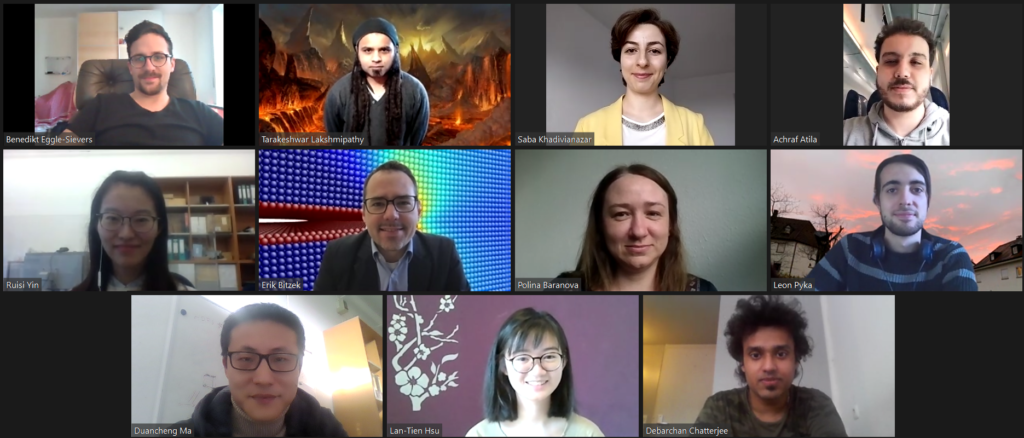Modellierung & Simulation

[seit 1.9.2021 am MPI Düsseldorf]
Die Materialmodellierungsgruppe unter der Leitung von Prof. Erik Bitzek erforscht die elementaren Defekte des kristallinen Gitters (Versetzungen, Risse, Grenzflächen, Leerstellen) und wie die Ordnung und Wechselwirkung dieser Defekte die mechanischen Eigenschaften von metallischen Werkstoffen beeinflussen. Die Arbeit der Gruppe umfasst zudem die Modellierung der mechanischen Eigenschaften von amorphen Systemen, wie Siliziumdioxid und metallischen Gläsern. In jedem der genannten Aufgabenfeldern werden atomistische Simulationen und Dichte-Funktional-Rechnungen angewendet, um detaillierte Informationen über Defekteigenschaften und Mechanismen zu erhalten, die zu Verformung und Versagen führen.
Der Forschungsschwerpunkt liegt darin, sowohl qualitative Einblicke als auch quantitative Informationen über die Deformationsprozesse auf der atomaren Skala zu erhalten. Diese Erkenntnisse helfen nicht nur dabei experimentelle Ergebnisse besser zu verstehen und zu interpretieren, sondern auch bei der Entwicklung robuster und zuverlässiger Modelle zur Vorhersage des Verformungsverhaltens von Materialien. Erkenntnisse aus atomistischen Simulationen werden in der Gruppe genutzt, um Multiskalenmodelle wie Kristallplastizitätsgerüste mit der Finite-Elemente-Methode (FEM) und der Fast-Fourier-Transformations-Methode (FFT) zu entwickeln. Diese Modelle überbrücken verschiedene Längenskalen und erleichtern die Simulation komplexer Umformprozesse.
Die Materialmodellierungsgruppe arbeitet eng mit dem Institut für Werkstoffsimulation (WW8) bei der Multiskalenmodellierung und mit dem Computer Chemistry Center (CCC) in Bezug auf die Dichtefunktionalrechnungen zusammen. Sie ist außerdem Teil des Exzellenzclusters Engineering of Advanced Materials (EAM) und des Zentralinstituts für Wissenschaftliches Rechnen (ZISC).
Andere Beteiligungen der Forschungsgruppe sind der Sonderforschungsbereich SFB/Transregio 103 „From Atoms to Turbine Blades“, das Schwerpunktprogramm SPP1594 „Topological Engineering of Ultrastrong Glasses“ und „SPP1466 Life“ sowie am Graduiertenkolleg 1869 „In-Situ Microscopy with Electrons, X-rays and Scanning Probes“. Darüber hinaus partizipiert die Gruppe am EU-Projekt iSTRESS und am Forschungsnetzwerk „Mechanics of Nano-objects MECANO“. Erik Bitzek wurde außerdem kürzlich mit einem ERC Consolidator Grant für sein Projekt „Microscopic Origins of Fracture Toughness“ (microKIc) ausgezeichnet.cheng
Prof. Dr.-Ing. Erik Bitzek, Privatdozent
Department Werkstoffwissenschaften (WW)
Lehrstuhl für Werkstoffwissenschaften (Allgemeine Werkstoffeigenschaften)
- Telefon: +49 9131 85-27507
- E-Mail: erik.bitzek@ww.uni-erlangen.de
Achraf Atila, M. Sc.
Department Werkstoffwissenschaften (WW)
Lehrstuhl für Werkstoffwissenschaften (Allgemeine Werkstoffeigenschaften)
- Telefon: +49 9131 85-27486
- E-Mail: achraf.atila@fau.de
Benedikt Eggle-Sievers, M.Sc.
Department Werkstoffwissenschaften (WW)
Lehrstuhl für Werkstoffwissenschaften (Allgemeine Werkstoffeigenschaften)
- Telefon: +49 9131 85-27486
- E-Mail: benedikt.eggle-sievers@fau.de
Saba Khadivianazar, M. Sc.
Department Werkstoffwissenschaften (WW)
Lehrstuhl für Werkstoffwissenschaften (Allgemeine Werkstoffeigenschaften)
- Telefon: +49 9131 85-27486
- E-Mail: saba.khadivianazar@fau.de
Lakshmipathy, Tarakeshwar
Amorphe, anorganische Materialien können extrem hohe Festigkeiten aufweisen, leiden aber in der Regel unter sehr begrenzter Bruchzähigkeit. In den letzten Jahren ist die Nachfrage nach ultrastarken, schadensresistenten Gläsern gestiegen. Eine signifikante Erhöhung der Zähigkeit für neue glasartige Materialien wird jedoch nur mit einem neuen Maß an konzeptionellem Verständnis der zugrundeliegenden Verformungsmechanismen und ihrer Beziehung zur lokalen Struktur und Netzwerktopologie möglich sein.
→ Mehr Informationen
Die Erforschung des Materialversagens und dessen Zusammenhang mit der Mikrostruktur eines Materials steht im Mittelpunkt der Materialwissenschaften. Ob eine beanspruchte Komponente spröde oder duktil bricht, wird durch die Fähigkeit der Materialien bestimmt, elastische Energie in plastische Arbeit umzuwandeln. Die plastische Energie-Dissipation während dem Bruch wird durch die Erzeugung und Bewegung von Versetzungen am Riss bestimmt. Wir verwenden groß angelegte, vollständig dreidimensionale atomistische Simulationen, um einzelne Risse und das Zusammenspiel von statischen und sich ausbreitenden Rissen mit Versetzungen, Korngrenzen und anderen Elementen der Mikrostruktur zu untersuchen.
→ Mehr Informationen
Die plastische Verformung von Metallen wird durch die Bewegung von Versetzungen getragen. Trotz ihrer Bedeutung für Prozesse mit hoher Dehnrate wie Hochgeschwindigkeitsschneiden sind die Parameter, die die Bewegung von Versetzungen bei hohen Geschwindigkeiten bestimmen, noch nicht vollständig verstanden. In diesem Projekt untersuchen wir die beschleunigte Bewegung von Versetzungen in verschiedenen kfz-Metallen bei unterschiedlichen Temperaturen und Belastungen sowie deren Wechselwirkung mit Hindernissen.
→ Mehr Informationen
Amorphous, inorganic materials can show extremely high strengths but usually suffer from very limited fracture toughness. The recent years have seen a rising The glide of dislocations and their interaction with obstacles determines the plastic deformation of metals. Structural materials usually consist of many crystallites (“grains”) of different orientations. The boundaries between these grains are strong obstacles to the propagation of slip.
→ Mehr Informationen
The mechanical properties of metal structures change dramatically when their characteristic length scale is of the order of micrometers of below. Nanosized metallic wires, pillars, particles or thin films show for example an increased yield stress (the so-called “smaller is stronger” effect), and changes in their elastic response compared to their bulk counterparts.
→ Mehr Informationen
Nanocrystalline materials are characterized by typical grain sizes below 100 nm. These materials exhibit strengths up to ten times higher than that of conventional polycrystalline materials, whilst most of them simultaneously show a significant decrease in ductility. A detailed understanding of the deformation and failure mechanisms is imperative to controlling and tailoring the mechanical properties of this new class of materials. Here, atomistic simulations provide a unique way to study the dislocation and grain boundary processes involved in plastic deformation.
→ Mehr Informationen
The performance and lifetime of small-scale materials and devices (nanostructured materials, thin films, MEMS, …) are critically influenced by intrinsic stresses resulting from manufacturing. However, the established techniques for micron-scale measurements of residual stresses still have strong limitations. The goal of the EU-project “Pre-standardisation of incremental FIB micro-milling for intrinsic stress evaluation at the sub-micron scale” (iSTRESS) was to develop an innovative protocol for the analysis of residual stress distribution on a (sub)micron-scale.
→ Mehr Informationen
Nickelbasis-Superlegierungen weisen außergewöhnliche mechanische Eigenschaften bei hohen Temperaturen auf und sind Schlüsselmaterialien für Turbinenschaufeln in Strahltriebwerken und Gasturbinen. Da die mechanischen Eigenschaften dieser Superlegierungen stark von der Mikrostruktur abhängen, spielen die Wechselwirkungen von Versetzungen in den γ-Kanälen mit den γ‘-Ausscheidungen eine wichtige Rolle bei der herausragenden Festigkeit dieser Legierungen bei hohen Temperaturen.
→ Mehr Informationen
High entropy alloys (HEAs) are chemically complex single-phase alloys with simple crystal structure. They are a novel class of alloy systems with five or more elements at near equiatomic composition with the potential of achieving non-incremental advances in mechanical properties. It is assumed that the high configurational entropy in these alloys stabilizes the single phase despite a significant energetic cost, as the disordered arrangement of atoms implies large atomic-scale lattice distortions.
→ Mehr Informationen
Interfaces and dislocation-interface interactions play an important role for development of alloys with improved mechanical properties. Many alloys, however, are characterized by the presence of complex intermetallic phases. Examples, which are currently investigated at our institute, are die-castable Mg alloys for automotive applications.
→ Mehr Informationen
Der Mikro-Freischwing-Biegetest wird häufig auf Mikro-Skala-Proben für Bruchzähigkeit angewendet. Durch die geringe Größe der Proben bestehen sie in der Regel aus einkristalline Materialien, bei denen die zugrundeliegende Verformung stets anisotrop ist. Dennoch wird meist die isotrope Theorie angewendet, um die Bruchzähigkeit in Experimenten zu bewerten.
→ Mehr Informationen
Metallische Nanostrukturen erhalten derzeit viel Aufmerksamkeit aufgrund ihrer oft überlegenen mechanischen Eigenschaften im Vergleich zu Schüttgütern [1]. In ähnlicher Weise haben nanokristalline und insbesondere nanoverstärkte Metalle in letzter Zeit wegen ihrer hohen Streckgrenze großes Interesse erregt [2].
→ Mehr Informationen
Risse sind für die Festigkeit eines Materials entscheidend. Die klassische Annahme ist, dass ein halb so großer Bauteil nur die Hälfte an Last tragen kann. Doch ein Riss der zur Hälfte durch ein Bauteil geht reduziert diese ertragbare Last auf einen Bruchteil. Dabei erzeugt der Riss durch seine scharfe und spitze Geometrie eine Spannungsüberhöhung an seiner Front, welche das Material an der Rissspitze versagen lässt. Dieses Versagen setzt sich durch das ganze Bauteil hindurch fort und führt zum Versagen. Spröde Materialien werden daher selbst durch mikroskopisch kleine Risse massiv geschwächt, wohingegen duktile Materialien den Riss abstumpfen lassen.
→ Mehr Informationen
- , , , , , , , , , , , , :
Microscopic Deformation Modes and Impact of Network Anisotropy on the Mechanical and Electrical Performance of Five-fold Twinned Silver Nanowire Electrodes
In: ACS nano (2020), Art.Nr.: acsnano.0c06480
ISSN: 1936-0851
DOI: 10.1021/acsnano.0c06480 - , , , , , , :
Assessment and optimization of the fast inertial relaxation engine (FIRE) for energy minimization in atomistic simulations and its implementation in LAMMPS
In: Computational Materials Science 175 (2020), Art.Nr.: 109584
ISSN: 0927-0256
DOI: 10.1016/j.commatsci.2020.109584 - , , , , , , , , , :
Combining Experiments and Atom Probe Tomography-Informed Simulations on γ′ Precipitation Strengthening in the Polycrystalline Ni-Base Superalloy A718Plus
In: Advanced Engineering Materials (2020)
ISSN: 1438-1656
DOI: 10.1002/adem.202000149 - , , , , , , , , :
In-situ observation of the initiation of plasticity by nucleation of prismatic dislocation loops
In: Nature Communications 11 (2020), Art.Nr.: 2367
ISSN: 2041-1723
DOI: 10.1038/s41467-020-15775-y - , , , :
On the presence of nanoscale heterogeneity in Al70Ni15Co15 metallic glass under pressure
In: Journal of Non-Crystalline Solids 550 (2020), Art.Nr.: 120381
ISSN: 0022-3093
DOI: 10.1016/j.jnoncrysol.2020.120381 - , , , , , :
Origins of strengthening and failure in twinned Au nanowires: Insights from in−situ experiments and atomistic simulations
In: Acta Materialia 187 (2020), S. 166-175
ISSN: 1359-6454
DOI: 10.1016/j.actamat.2020.01.038 - , , , :
Alumina effect on the structure and properties of calcium aluminosilicate in the percalcic region: A molecular dynamics investigation
In: Journal of Non-Crystalline Solids 525 (2019), Art.Nr.: 119470
ISSN: 0022-3093
DOI: 10.1016/j.jnoncrysol.2019.119470 - , , , :
Atomistic insights into the impact of charge balancing cations on the structure and properties of aluminosilicate glasses
In: Physical Review B 100 (2019)
ISSN: 0163-1829
DOI: 10.1103/PhysRevB.100.144109 - , , , , :
Atomistic simulations of basal dislocations in Mg interacting with Mg17Al12 precipitates
In: Materialia 7 (2019), Art.Nr.: 100355
ISSN: 2589-1529
DOI: 10.1016/j.mtla.2019.100355
URL: https://www.sciencedirect.com/science/article/pii/S2589152919301516?via=ihub - , , :
Effect of C on the Martensitic Transformation in Fe-C Alloys in the Presence of Pre-Existing Defects: A Molecular Dynamics Study
In: Crystals 9 (2019)
ISSN: 2073-4352
DOI: 10.3390/cryst9020099 - , , , , , , , , :
Microstructural dependence of the fracture toughness of metallic thin films: A bulge test and atomistic simulation study on single-crystalline and polycrystalline silver films
In: Journal of Materials Research 34 (2019), S. 3483-3494
ISSN: 0884-2914
DOI: 10.1557/jmr.2019.262
URL: https://www.cambridge.org/core/journals/journal-of-materials-research/article/microstructural-dependence-of-the-fracture-toughness-of-metallic-thin-films-a-bulge-test-and-atomistic-simulation-study-on-singlecrystalline-and-polycrystalline-silver-films/73FEF9FD56EFF314E1366003EFFE8C5B# - , , :
On solution mapping and remeshing in crystal plasticity finite element simulations: application to equal channel angular pressing
In: Modelling and Simulation in Materials Science and Engineering 27 (2019)
ISSN: 0965-0393
DOI: 10.1088/1361-651X/ab28e3 - , , , , , , , , :
{110} planar faults in strained bcc metals: Origins and implications of a commonly observed artifact of classical potentials
In: Physical Review Materials 2 (2018)
ISSN: 2475-9953
DOI: 10.1103/PhysRevMaterials.2.093606 - , :
Atomic-scale modeling of elementary processes during the fatigue of metallic materials: from crack initiation to crack-microstructure interactions
In: Christ, Hans-Jürgen (Hrsg.): Fatigue of Materials at Very High Numbers of Loading Cycles - Experimental Techniques, Mechanisms, Modeling and Fatigue Life Assessment, Wiesbaden: Springer Spektrum, 2018
ISBN: 978-3-658-24531-3
DOI: 10.1007/978-3-658-24531-3_2
URL: https://www.springer.com/de/book/9783658245306 - , , , :
Atomistic Simulations of Compression Tests on gamma-Precipitate Containing Ni3Al Nanocubes
In: Metallurgical and Materials Transactions A-Physical Metallurgy and Materials Science 49A (2018), S. 4158-4166
ISSN: 1073-5623
DOI: 10.1007/s11661-018-4706-0 - , , :
3D Aspects of Fracture and Effects due to Crack Front Curvature
In: 14th International Conference on Fracture (ICF 14) 2017 - , , , , :
Atomistic Simulation of Cracks versus Generalized Continua
In: 14th International Conference on Fracture (ICF 14) 2017 - , , :
Atomistic simulations of focused ion beam machining of strained silicon
In: Applied Surface Science 416 (2017), S. 86-95
ISSN: 0169-4332
DOI: 10.1016/j.apsusc.2017.04.027 - , :
Idealized vs. Realistic Microstructures: An Atomistic Simulation Case Study on γ/γ′ Microstructures
In: Materials 10 (2017)
ISSN: 1996-1944
DOI: 10.3390/ma10010088 - , :
Influence of Atomic-scale Heterogeneties on Fracture Behavior of B2 NiAl
In: 14th International Conference on Fracture (ICF 14) 2017 - , , :
Influence of grain boundary structure and topology on the plastic deformation of nanocrystalline aluminum as studied by atomistic simulations
In: International Journal of Plasticity 97 (2017), S. 107-125
ISSN: 0749-6419
DOI: 10.1016/j.ijplas.2017.05.11 - , :
BDA: A novel method for identifying defects in body-centered cubic crystals
In: MethodsX 3 (2016), S. 279-288
ISSN: 2215-0161
DOI: 10.1016/j.mex.2016.03.013
URL: http://www.sciencedirect.com/science/article/pii/S2215016116300036 - , , , , :
Graphene quantum dots: wave function mapping by scanning tunneling spectroscopy and transport spectroscopy of quantum dots prepared by local anodic oxidation
In: Physica Status Solidi-Rapid Research Letters 10 (2016), S. 24-38
ISSN: 1862-6254
DOI: 10.1002/pssr.201510164 - , , :
Influence of intrinsic strain on irradiation induced damage: the role of threshold displacement and surface binding energies
In: Materials and Design 111 (2016), S. 405-413
ISSN: 0261-3069
DOI: 10.1016/j.matdes.2016.08.077 - , , , , :
In situ mechanical quenching of nanoscale silica spheres in the transmission electron microscope
In: Scripta Materialia 121 (2016), S. 70-74
ISSN: 1359-6462
DOI: 10.1016/j.scriptamat.2016.04.019
URL: http://www.sciencedirect.com/science/article/pii/S1359646216301397 - , , :
Multiscale Materials Modeling: Approaches to Full Multiscaling
De Gruyter, Berlin, 2016 - , , , :
Nanosculpt: A methodology for generating complex realistic configurations for atomistic simulations
In: MethodsX 3 (2016), S. 219-230
ISSN: 2215-0161
DOI: 10.1016/j.mex.2016.03.002
URL: http://www.sciencedirect.com/science/article/pii/S2215016116000157 - , , , , :
On the transition from plastic deformation to crack initiation in the high- and very high-cycle fatigue regimes in plain carbon steels
In: International Journal of Fatigue (2016)
ISSN: 0142-1123
DOI: 10.1016/j.ijfatigue.2016.04.003
URL: http://www.sciencedirect.com/science/article/pii/S0142112316300512 - , , , , , , :
Quantifying eigenstrain distributions induced by focused ion beam damage in silicon
In: Materials Letters 185 (2016), S. 47-49
ISSN: 0167-577X
DOI: 10.1016/j.matlet.2016.08.111 - , , , , , , , , :
Size-Dependent Brittle-to-Ductile Transition in Silica Glass Nanofibers
In: Nano Letters 16 (2016), S. 105-113
ISSN: 1530-6984
DOI: 10.1021/acs.nanolett.5b03070 - , , , :
Wedge-shaped twins and pseudoelasticity in fcc metallic nanowires under bending
In: Extreme Mechanics Letters 8 (2016)
ISSN: 2352-4316
DOI: 10.1016/j.eml.2016.03.001 - , , , , :
A multiscale simulation framework of the accumulative roll bonding process accounting for texture evolution
In: Materials Science and Engineering A-Structural Materials Properties Microstructure and Processing 631 (2015), S. 104-119
ISSN: 0921-5093
DOI: 10.1016/j.msea.2015.02.005 - , , :
Atomistic aspects of fracture
In: International Journal of Fatigue 191 (2015), S. 13-30
ISSN: 0142-1123
DOI: 10.1007/s10704-015-9988-2 - , , , , , , , , , :
Atom probe informed simulations of dislocation-precipitate interactions reveal the importance of local interface curvature
In: Acta Materialia 92 (2015), S. 33-45
ISSN: 1359-6454
DOI: 10.1016/j.actamat.2015.03.050 - , , , , , , :
Controlling the diameter of aligned single-walled carbon nanotubes on quartz via catalyst reduction time
In: Carbon 95 (2015), S. 452-459
ISSN: 0008-6223
DOI: 10.1016/j.carbon.2015.08.058 - , , :
Impact of twin boundaries on bulk elastic constants: Density-functional theory data for Young's modulus of Ag
In: Data in Brief 3 (2015), S. 209-215
ISSN: 2352-3409
DOI: 10.1016/j.dib.2015.03.005 - , , :
Influence of anisotropic elasticity on the mechanical properties of fivefold twinned nanowires
In: Journal of the Mechanics and Physics of Solids 84 (2015), S. 358-379
ISSN: 0022-5096
DOI: 10.1016/j.jmps.2015.08.004 - , , , , , , , , , , , :
Nanotwinned silver nanowires: Structure and mechanical properties
In: Acta Materialia 92 (2015), S. 299-308
ISSN: 1359-6454
DOI: 10.1016/j.actamat.2015.02.041 - , :
On the influence of crack front curvature on the fracture behavior of nanoscale cracks
In: Engineering Fracture Mechanics 150 (2015), S. 197-208
ISSN: 0013-7944
DOI: 10.1016/j.engfracmech.2015.03.028 - , , , , :
Single-crystal nickel-based superalloys developed by numerical multi-criteria optimization techniques: Design based on thermodynamic calculations and experimental validation
In: Modelling and Simulation in Materials Science and Engineering 23 (2015), Art.Nr.: 035004
ISSN: 1361-651X
DOI: 10.1088/0965-0393/23/3/035004 - , , , :
A hierarchical multi-scale model for hexagonal materials taking into account texture evolution during forming simulation
In: Computational Materials Science 82 (2014), S. 464-475
ISSN: 0927-0256
DOI: 10.1016/j.commatsci.2013.10.023 - , , , :
Atomistic model analysis of local and global instabilities in crystals at finite temperature
In: Key Engineering Materials 592-593 (2014), S. 39-42
ISSN: 1013-9826
DOI: 10.4028/www.scientific.net/KEM.592-593.39 - , , :
Atomistic Simulations of Compression Tests on Ni3Al Nanocubes
In: Materials Research Letters 2 (2014), S. 140-145
ISSN: 2166-3831
DOI: 10.1080/21663831.2013.878884 - , :
Comparative study of embedded atom potentials for atomistic simulations of fracture in α-iron
In: Modelling and Simulation in Materials Science and Engineering 22 (2014), Art.Nr.: 045002
ISSN: 0965-0393
DOI: 10.1088/0965-0393/22/4/045002 - , :
Fracture toughness and bond trapping of grain boundary cracks
In: Acta Materialia 73 (2014), S. 1-11
ISSN: 1359-6454
DOI: 10.1016/j.actamat.2014.03.035 - , , , , , , , :
Reversible cyclic deformation mechanism of gold nanowires by twinning-detwinning transition evidenced from in situ TEM
In: Nature Communications 5 (2014), Art.Nr.: 3033
ISSN: 2041-1723
DOI: 10.1038/ncomms4033 - , :
Shearing in a biomimetic apatite-protein composite: Molecular dynamics of slip zone formation, plastic flow and backcreep mechanisms
In: PLoS ONE 9 (2014), Art.Nr.: e93309
ISSN: 1932-6203
DOI: 10.1371/journal.pone.0093309 - , , , :
Atomistic Model Analysis of Local and Global Instabilities in Crystals at Finite Temperature
In: Key Engineering Materials 592-593 (2013), S. 39-42
ISSN: 1013-9826
DOI: 10.4028/www.scientific.net/KEM.592-593.39
URL: https://www.scientific.net/KEM.592-593.39 - , , :
FE2AT - Finite element informed atomistic simulations
In: Modelling and Simulation in Materials Science and Engineering 21 (2013)
ISSN: 0965-0393
DOI: 10.1088/0965-0393/21/5/055011 - , :
Mechanisms of dislocation multiplication at crack tips
In: Acta Materialia 61 (2013), S. 1394-1403
ISSN: 1359-6454
DOI: 10.1016/j.actamat.2012.11.016 - , , , :
Controlled Evolution of Coincidence Site Lattice Related Grain Boundaries
In: Transactions of the Indian Institute of Metals 69 (2016), S. 1745-1753
ISSN: 0975-1645
DOI: 10.1007/s12666-016-0834-7 - , , , :
Influence of specimen geometry on temperature increase during ultrasonic fatigue testing
In: Ultrasonics 53 (2013), S. 1412-1416
ISSN: 1874-9968
DOI: 10.1016/j.ultras.2013.04.021 - , , , , , :
Existence of two twinning-mediated plastic deformation modes in Au nanowhiskers
In: Acta Materialia 60 (2012), S. 3985-3993
ISSN: 1359-6454
DOI: 10.1016/j.actamat.2012.03.018 - , , , , , :
Finding activation pathway of coupled displacive-diffusional defect processes in atomistics: Dislocation climb in fcc copper
In: Physical Review B 86 (2012)
ISSN: 0163-1829
DOI: 10.1103/PhysRevB.86.014115 - , :
Corrigendum to “A simple dislocation model of deformation resistance of ultrafine-grained materials explaining Hall-Petch strengthening and enhanced strain rate sensitivity” (Acta Materialia (2009) 57 (1966-1974))
In: Acta Materialia 59 (2011)
ISSN: 1359-6454
DOI: 10.1016/j.actamat.2011.05.032 - , , , , , :
Diffusive molecular dynamics and its application to nanoindentation and sintering
In: Physical Review B 84 (2011)
ISSN: 0163-1829
DOI: 10.1103/PhysRevB.84.054103 - , , , :
Influence of dislocation density on the pop-in behavior and indentation size effect in CaF2 single crystals: Experiments and molecular dynamics simulations
In: Acta Materialia 59 (2011), S. 4264-4273
ISSN: 1359-6454
DOI: 10.1016/j.actamat.2011.03.050 - , , , :
Atomistic simulation of dislocation-void interactions under cyclic loading
In: Modelling and Simulation in Materials Science and Engineering 18 (2010)
ISSN: 0965-0393
DOI: 10.1088/0965-0393/18/2/025006 - , , :
Ab initio investigation of diamond coatings on steel
In: Scripta Materialia 60 (2009), S. 504-507
ISSN: 1359-6462
DOI: 10.1016/j.scriptamat.2008.11.042 - , :
Dislocation mechanics of creep
In: Materials Science and Engineering A-Structural Materials Properties Microstructure and Processing 510-511 (2009), S. 7-13
ISSN: 0921-5093
DOI: 10.1016/j.msea.2008.04.110 - , , , , , , , :
Microstructural evolution during deformation of tin dioxide nanoparticles in a comminution process
In: Acta Materialia 57 (2009), S. 3060-3071
ISSN: 1359-6454
DOI: 10.1016/j.actamat.2009.02.049 - , , , :
The correlation between the internal material length scale and the microstructure in nanoindentation experiments and simulations using the conventional mechanism-based strain gradient plasticity theory
In: Journal of Materials Research 24 (2009), S. 1197-1207
ISSN: 0884-2914
DOI: 10.1557/jmr.2009.0123 - , , :
Modelling the transition from strengthening to softening due to grain boundaries
In: Materials Science and Engineering A-Structural Materials Properties Microstructure and Processing 483-484 (2008), S. 95-98
ISSN: 0921-5093
DOI: 10.1016/j.msea.2006.09.130 - , :
Stresses to bow edge dislocation segments out of di-/multipolar edge dislocation bundles
In: Materials Science and Engineering A-Structural Materials Properties Microstructure and Processing 483-484 (2008), S. 469-473
ISSN: 0921-5093
DOI: 10.1016/j.msea.2006.09.185 - , , , :
The strength limit in a bio-inspired metallic nanocomposite
In: Journal of the Mechanics and Physics of Solids 56 (2008), S. 1086-1104
ISSN: 0022-5096
DOI: 10.1016/j.jmps.2007.06.006 - Durst Karsten, Göken Mathias, Verhoff Horst:
Finite element study for nanoindentation measurements on two-phase materials
In: Journal of Materials Research 19 (2004), S. 85-93
ISSN: 0884-2914 - , , , :
Atomistic insights into the structure and elasticity of densified 45S5 bioactive glasses
In: Physical Chemistry Chemical Physics (2021)
ISSN: 1463-9076
DOI: 10.1039/d1cp02192c - , , , , , , , , , , , :
Element-resolved local lattice distortion in complex concentrated alloys: An observable signature of electronic effects
In: Acta Materialia 216 (2021), Art.Nr.: 117135
ISSN: 1359-6454
DOI: 10.1016/j.actamat.2021.117135 - , , , , , , , :
How Will Your Tweet Be Received? Predicting the Sentiment Polarity of Tweet Replies
IEEE 15th International Conference on Semantic Computing (ICSC) (Laguna Hills, CA, 27. Januar 2021 - 29. Januar 2021)
In: IEEE (Hrsg.): 2021 IEEE 15th International Conference on Semantic Computing (ICSC) 2021
DOI: 10.1109/ICSC50631.2021.00068
URL: https://ieeexplore.ieee.org/document/9364527 - , , , , :
Laves phase crystal analysis (LaCA): Atomistic identification of lattice defects in C14 and C15 topologically close-packed phases
In: Journal of Materials Research (2021)
ISSN: 0884-2914
DOI: 10.1557/s43578-021-00237-y - Durst Karsten, Göken Mathias, Pharr G.M.:
Finite element simulation of spherical indentation in the elastic / plastic transition
In: Zeitschrift für Metallkunde 93 (2002), S. 857-861
ISSN: 0044-3093 - , , , , :
Pinning of extended dislocations in atomically disordered crystals
In: Acta Materialia 236 (2022)
ISSN: 1359-6454
DOI: 10.1016/j.actamat.2022.118095 - , , , , , :
Surface strain evolution of ultrafme-grained aluminum alloy laminates under tension - Microscale plastic instabilities and the Portevin-Le Chatelier effect
In: Scripta Materialia 68 (2013), S. 809-812
ISSN: 1359-6462
DOI: 10.1016/j.scriptamat.2013.01.036 - , , , , :
Fracture ab initio: A force-based scaling law for atomistically informed continuum models
In: Journal of Materials Research 33 (2018), S. 3750-3761
ISSN: 0884-2914
DOI: 10.1557/jmr.2018.384
URL: https://www.cambridge.org/core/journals/journal-of-materials-research/article/fracture-ab-initio-a-forcebased-scaling-law-for-atomistically-informed-continuum-models/077AFC469E3C82F3D1A537EA83AEF5F6# - , , :
Atomistic Simulations of Dislocation-Void Interactions in Concentrated Solid Solution Alloys
In: Metals 13 (2023), Art.Nr.: 1655
ISSN: 2075-4701
DOI: 10.3390/met13101655 - , , , :
Effects of interatomic potential on fracture behaviour in single- and bicrystalline tungsten
In: Computational Materials Science 207 (2022), Art.Nr.: 111283
ISSN: 0927-0256
DOI: 10.1016/j.commatsci.2022.111283 - , , , , , , :
On the influence of Al-concentration on the fracture toughness of NiAl: Microcantilever fracture tests and atomistic simulations
In: Acta Materialia 234 (2022), Art.Nr.: 117996
ISSN: 1359-6454
DOI: 10.1016/j.actamat.2022.117996




